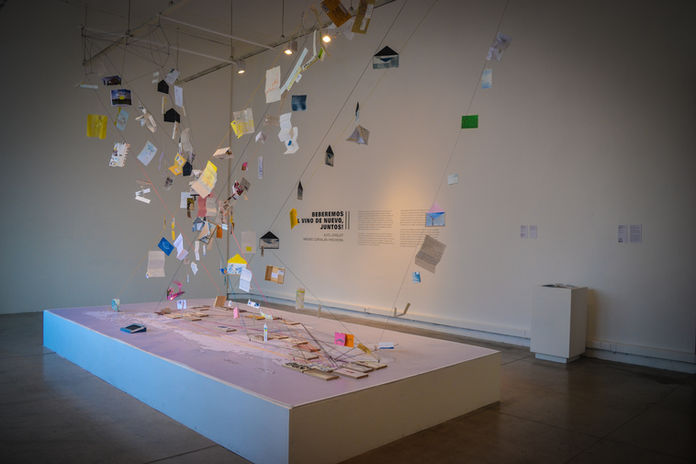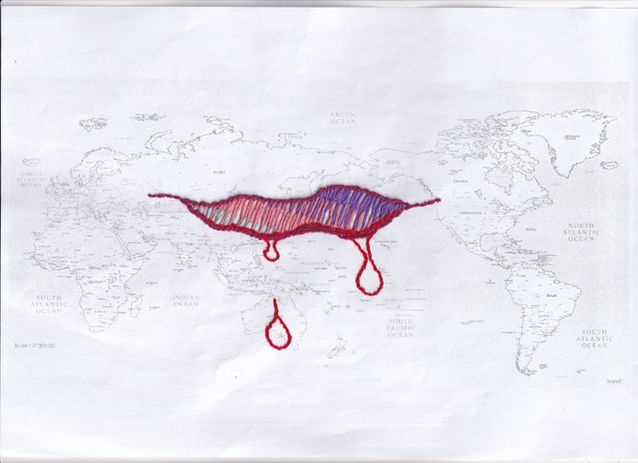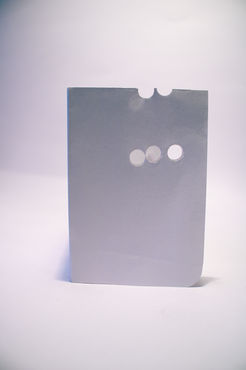
Exhibition
Let Us Drink The New Wine, Together! explores practices for continuing artistic friendships and creative exchanges through conditions of intense separation. An archive of miniature works of art created in collaboration with more than 60 artists from all continents of the world during 2020-2022 spirals through space, organized as a kind of affective weather system of human connection, moving beyond the human control.
The project has explored methods to allow artists from around the world, with whom artists alys longley and Máximo Corvalán-Pincheira had previously worked, to collaborate through a series of counter maps, mail art works, performance strategies and experiments in the creation of virtual exhibitions. spaces, inspired by the surreal game of the 'exquisite corpse'. To begin with, more than 34 artists from around the world were invited to physically and digitally intervene on a world map, via email. Next, miniature mail art, postmarks, and video art pieces were accumulated as the project traveled from artist to artist, viewing artistic practice and solidarity as an “essential service.” As Catalina Mena writes in her curatorial text about this project:
Against the suspension of time and physical isolation, the work activates a circulation process that brings together what is separated. Creative subjectivities intersect, overlap and intermingle, creating a planetary choreography. While the world falls, the work rebuilds it. Each gesture interacts with the other, affects and is affected, contaminates and is contaminated, in a transforming game of affects.
This resulting exhibition deviates through art forms and technical languages: drawing, performance, choreography, embroidery, poetry, video, virtual exhibition, and counter-mapping. At a time of deep uncertainty, this project proposes that making new meanings out of and through chaos is a responsibility of artists. From Australasia to Africa, from South America to Europe, from Asia, from North America to Chile, this project presents a chaotic archive of precarious documents that may be insubstantial individually, but that collectively testify to the vitality of small acts of continuation to invigorate what language can be, through a dedicated accumulation of simple gestures of touch and connection across languages and continents.
Emergency! Let us drink the new wine, together!
-Catalina Mena
The twenties of the 20th century, end of the first war. Moment of uncertainty and fall. The anachronistic echo of a now is heard. The world has collapsed and the hope of a possible future is still fragile in the air. Ten million dead weigh on recent memory, then they will multiply. They are numbers. (The images are under threat).
A group of artists, under the label of Surrealism, join forces with the desire to survive the mad rationality of war. The urgency is to unite to generate a collective work that is a game, a poem, a provocation against the prevailing logic and its destructive mandates. It is about trying out other ways of saying, combining phrases and drawings according to random mechanisms, obeying the rhythm of the unconscious. Each one performs his creative action hiding it from the next one, so that no one is conditioned by the previous gesture. In this way, actions are added toform a larger work, chaotic in its structure. From there emerges a first phrase with no apparent meaning, but full of resonances: “The exquisite corpse will drink the new wine”. (The evangelists are heard retelling The Last Supper).
Language builds the world. Poetry is its raw word.
André Breton, who carries the rod, says that the extravagant fun has allowed them to “escape from self-criticism and free the metaphorical activity of the mind.”
March 2020. (The number 20, which is repeated in this story, is the number of the end). The artist alys longley, from New Zealand, and the artist Máximo Corvalán, from Chile, are planning to develop a project together.
A global pandemic is declared, confinement is decreed, the project is suspended. Time stands still, uncertainty settles in, the idea of an end looms. The dead are numbers (the images are under threat).
alys and Máximo continue the dialogue at a distance; their messages cross the space. They think of the others, of all those artists with whom they have maintained an affective bond, who are scattered in different parts of the world, each one locked up at home. Staying in touch is a form of resistance.
This is how this fiction begins. They rehearse modes of connection mediated by artistic desire. More than 60 artists, from all continents, are linked to create a series of analog and digital works, crossing borders and circumventing controls. The gesture summons the emergency. Art as a utopia of communion. Bodies are saved from absence.
Against the suspension of time and physical isolation, the work activates a process of circulation that brings together what is separated. Creative subjectivities intersect, overlap and intermingle, creating a planetary choreography. As the world falls down, the work rebuilds it. Each gesture interacts with the other, affects and is affected, contaminates and is contaminated, in a transforming game of affections. It is a work, then, that emerges from movement and remains moving, that is why it resists all emplacement.
When the work appears, becomes visible, it is always as a ghost, as a record of something that escapes. Here its rebellious and vital character: transgressing the mandates of asepsis, social distance, geopolitical borders and also the rules of art. Work that disconcerts the form, the discourse and the authorship; work that is pure relational action. ___
The poetry book Theogony, written by Hesiod in VII BC, describes the beginning of the universe and the lineage of the gods of Greek mythology. According to this text, Chaos is the first thing that existed and gave rise to other deities. The cosmogonic figure of the Earth is also posterior to Chaos, which is why many considered it to be the daughter of Chaos.The state of emergency makes the body tremble. The dead are still numbers. The world has ceased to function, or is functioning in a way that seems chaotic to us. Perhaps the world is revealing its true character, so says the French philosopher Bruno Latour. That it was never an organism, nor an ordered system composed of parts that fulfill a function. There is no engineer regulating the interactions, nor a cause leading to a result. “Life is more chaotic than economists and Darwinians had imagined,” he says. That the earth is a living entity, a “nice little jumble” -that’s what he calls it--, where thousands of actors interact and modify each other. This interaction produces “waves of action” that do not respect any border or fixed scale. These waves, he says, are the realactors.
When we replace the idea of a system or an organism with the idea of “waves of action” chaos becomes natural. We look at the complexity of the living: millions of related parts whose interactions do not respond to the laws of causality, nor are they visible to our eyes. There are too many hidden variables that prevent us from understanding the whole. We are part of an interdependent, diverse, uncertain, random network; we move in temporality and are always recreating ourselves, in a state of emergency (in the double sense of urgency and birth).
Perhaps what we call chaotic is simply that which we cannot understand from rational logic. In order to transit uncertainty without fear, it would be necessary to accept the limits of reason: to make a crack in the language.
The artistic project Let Us Drink New Wine, Together! reproduces, in a way, the performativity of the Earth. “If it is an opera, it depends on constant improvisation that has neither score
nor outcome,” Latour would say. The work is process, daughter of necessity and chance: it entangles itself with the vital and celebrates entropy.
Choral work: the feeling is expressed collectively. Here Mikhail Bakhtin, philosopher of language. This Russian spoke of polyphony by studying the works of Dostoevsky, where voices are superimposed.
The individual self merges into a plural entity that is traversed by language: it is the political subject that interacts and blends. Place of affection. Art is activated in contact.
The idea of authorship creeps under the sign of the question, for it comes to reaffirm the fantasy of the organism made of isolated parts, of individual brains that invent things. Like Latour, Bakhtin says that we are members of a plot in movement. Later Roland Barthes will say that the work does not belong to the author, but to the culture, because it is the product of a history of thoughts and images that are exchanged and remembered. What speaks is language, and not the author. Perhaps language is that wine that we will drink, each time, together.


















































































































